Enzymes(酶)
Enzymes are very efficient and specific catalyst proteins which react with 1 or few types of substrates in biochemical reactions and are responsible for bringing about almost all of the chemical reactions in living organisms. Enzymes speed up reactions by providing an alternative reaction pathway of lower activation energy. Without enzymes, reactions take place at a rate far too slow for the pace of metabolism which means that they speed up the chemical reactions in living things.
There are 2 types of enzymes, ones that help join specific molecules together to form new molecules & others that help break specific molecules apart into separate molecules. Enzymes play many important roles ouside the cell as well. One of the best examples of this is the digestive system. For instance, it is enzymes in your digestive system that break food down in your digestive system break food down into small molecules that can be absorbed by the body. Some enzymes in your digestive system break down starch, some proteins and others break down fats. The enzymes used to digest our food are extra-cellular since they are located outside our cells & enzymes inside our cells are intra-cellular enzymes. Enzymes are used in ALL chemical reactions in living things; this includes respiration, photosynthesis, movement growth, getting rid of toxic chemicals in the liver and so on. Enzymes are proteins that must have the correct structure to be active. They are very easily affected by heat, pH and heavy metal ions.
Ribonucleoprotein enzyme catalytic activity is located in the protein part but for some the catalytic activity is in the RNA part. A catalyst is any substance which makes a chemical reaction go faster, without itself being changed. A catalyst can be used over and over again in a chemical reaction and does not get used up.
Enzymes lower the amount of activation energy needed by binding to the reactants of the reaction they catalyze, thus speed up the reaction and can process millions of molecules per second. Enzymes are typically large proteins with high molecular weight that permit reactions to go at conditions that the body can tolerate.
Enzyme nomenclature is based on what the enzyme reacts with & how it reacts along with the ending ase.
Enzymes must get over the activation energy hurdle.
Enzymes change how a reaction will proceed which reduces the activation energy and makes it faster. The more we increase the enzyme concentration the faster the reaction rate for non-catalyzed reactions. Enzymes that are catalyzed reactions also increase reaction rate at higher level of concentration but up to a certain point called Vmax which means that the enzyme has reached its maximum point. The reaction is limited by both the concentrations of the enzyme and substrate. Enzymes as catalysts take part in reactions which provide an alternative reaction pathway. Enzymes do not undergo permanent changes and remain unchanged at the end of the reaction. They only change the rate of reaction, not the position of the equilibrium.Enzymes as catalysts are highly selective by only catalysing specific reactions due to the shapes of the enzyme’s molecule.
Enzymes contain a globular protein part called apoenzyme and a non-protein part named cofactor or prosthetic group or metal-ion-activator. Changes in temperature and pH have great influence on the intra- and intermolecular bonds that hold the protein part in their secondary and tertiary structures.
Examples of cofactors are 1. Prosthetic group that are permanently bound to the enzyme. 2. Activator group which are cations (positively charged metal ions) & temporarily bind to the active site of the enzyme. 3.Coenzymes, usually vitamins or made from vitamins which are not permanently bound to the enzyme molecule, but combine with the enzyme-substrate complex temporarily. Enzymes require the presence cofactors before their catalytic activity can be exerted. This entire active complex is referred to as the holoenzyme.
Without enzymes, our guts would take weeks to digest our food, our muscles, nerves and bones would not work properly and so on…
Main Enzyme category groups:
Oxidoreductases:
All enzymes that catalyse oxido-reductions belong in this class. The substrate oxidized is regarded as a hydrogen or electron donor. The classification is based on 'donor:acceptor oxidoreductase'. The common name is 'dehydrogenase', wherever this is possible; as an alternative, 'acceptor reductase' can be used. 'Oxidase' is used only where O2 is an acceptor. Classification is difficult in some cases, because of the lack of specificity towards the acceptor.
Transferases:
Transferases are enzymes that transfer a group, for example, the methyl group or a glycosyl group, from one compound (generally regarded as donor) to another compound (generally regarded as acceptor). The classification is based on the scheme 'donor:acceptor grouptransferase'. The common names are normally formed as 'acceptor grouptransferase' or 'donor grouptransferase'. In many cases, the donor is a cofactor (coenzyme) that carries the group to be transferred. The aminotransferases constitute a special case.
Hydrolases:
These enzymes catalyse the hydrolysis of various bonds. Some of these enzymes pose problems because they have a very wide specificity, and it is not easy to decide if two preparations described by different authors are the same, or if they should be listed under different entries. While the systematic name always includes 'hydrolase', the common name is, in most cases, formed by the name of the substrate with the suffix -ase. It is understood that the name of the substrate with this suffix, and no other indicator, means a hydrolytic enzyme. It should be noted that peptidases have recommended names rather than common names.
Lyases:
Lyases are enzymes that cleave C-C, C-O, C-N and other bonds by means other than by hydrolysis or oxidation. They differ from other enzymes in that two (or more) substrates are involved in one reaction direction, but there is one compound fewer in the other direction. When acting on the single substrate, a molecule is eliminated and this generates either a new double bond or a new ring. The systematic name is formed according to 'substrate group-lyase'. In common names, expressions like decarboxylase, aldolase, etc. are used. 'Dehydratase' is used for those enzymes that eliminate water. In cases where the reverse reaction is the more important, or the only one to be demonstrated, 'synthase' may be used in the name.
Ligases:
Ligases are enzymes that catalyse the joining of two molecules with concomitant hydrolysis of the diphosphate bond in ATP or a similar triphosphate. 'Ligase' is often used for the common name, but, in a few cases, 'synthase' or 'carboxylase' is used. 'Synthetase' may be used in place of 'synthase' for enzymes in this class.
Products for Enzymes
- 41701(11)
- Activating Transcription Factor(3)
- Adenylate Kinase(10)
- AHCY(3)
- Aldolase(9)
- Asparaginase(5)
- Aurora Kinase(18)
- Beta Lactamase(3)
- Calcium and Integrin Binding(2)
- Calcium/Calmodulin-Dependent Protein Kinase(4)
- Carbonic Anhydrase(49)
- Casein Kinase(36)
- Cathepsin(52)
- Chitinase(5)
- Creatin Kinases(9)
- Cyclin(7)
- Cyclin-Dependent Kinase(18)
- Cyclophilin(23)
- Deaminase(14)
- Decarboxylase(12)
- Dehydrogenase(96)
- Discoidin Domain Receptor Tyrosine Kinase(2)
- DNA Polymerase(4)
- EGF Receptor(3)
- Endonuclease(6)
- Enolase(10)
- Enterokinase(5)
- Epimerase(3)
- Esterase(15)
- FGF Receptors(12)
- FK506 Binding Protein(10)
- Fructosamine 3 Kinase(2)
- Galactosidase(5)
- Glucosidase(32)
- Gluteradoxin(7)
- Glycogen synthase kinase(2)
- Glycosylase(10)
- Glyoxalase(3)
- Granzyme(7)
- Guanylate Kinase(2)
- Heparanase(2)
- Histone Deacetylase(3)
- Hydratase(10)
- Hydrolase(33)
- Hydroxylase(6)
- Isomerase(26)
- Jun N-terminal Kinase(1)
- Jun Proto-Oncogene(2)
- Kallikrein(26)
- Ligase(4)
- Lipase(14)
- Lipocalin(6)
- Lyase(9)
- LYVE1(3)
- Mitogen-Activated Protein Kinase(16)
- MMP(68)
- Mutase(11)
- Natural Enzymes(4)
- Nuclease(18)
- Nucleotidase(4)
- Nudix Type Motif(11)
- Other Enzymes(63)
- Oxidase(23)
- Oxygenase(12)
- Paraoxonase(3)
- Peptidase(41)
- Peroxiredoxin(10)
- Phosphatase(150)
- Phosphorylase(9)
- PI3-kinase(5)
- Polymerase(13)
- PPARG(2)
- Protease(15)
- Proteasome(54)
- Protein Kinase Akt1/PKB alpha(4)
- Protein Kinase-A(7)
- Protein Kinase-C(3)
- Protein Kinases(86)
- Protein Tyrosine Phosphatase(10)
- Reductase(60)
- Secreted Phospholipase A2(10)
- Serine Threonine Kinase(4)
- Sulfatase(8)
- Synthase(23)
- Synthetase(33)
- TGFBR(3)
- TGM2(3)
- TIMP(10)
- TPA(4)
- Transferase(156)
- Tyrosine Kinase(9)
- Ubiquitin Conjugating Enzyme(39)
- Uromodulin(4)
- VEGF Receptors(14)
- Transaminase(19)
- Hexokinase(6)
- TIE1(6)
- Cat.No. 产品名称 Information
-
GP21998
NEU1 Human
Sialidase 1 Human Recombinant

-
GC69554
NFF-3 TFA
NFF-3 TFA 肽是一种选择性 MMP 底物。NFF-3 TFA 选择性结合 MMP-3 和 MMP-10 而被水解。NFF-3 TFA 也被胰蛋白酶、肝细胞生长因子激活剂和因子 Xa 裂解。使用 CyDye Cy3/Cy5Q 标记 NFF-3 TFA,可在细胞实验中产生荧光,而检测细胞活性。
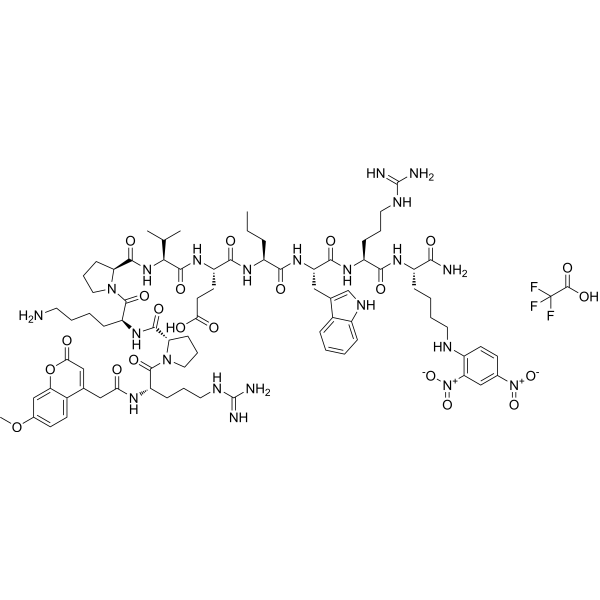
-
GP21999
NFNB E.Coli
二氢蝶啶还原酶大肠杆菌重组体

-
GP22000
NIT2 Human
Nitrilase Family Member 2 Human Recombinant

-
GP22569
NME2 Rat
Non-Metastatic Cells 2 Rat Recombinant

-
GP22001
NMNAT1 Human
Nicotinamide Nucleotide Adenylyltransferase 1 Human Recombinant

-
GP22002
NMNAT1 Human, Active
Nicotinamide Nucleotide Adenylyltransferase 1 Human Recombinant , Active

-
GP22003
NMNAT1 Mouse
Nicotinamide Nucleotide Adenylyltransferase 1 Mouse Recombinant

-
GP22004
NMNAT2 Human
Nicotinamide Nucleotide Adenylyltransferase 2 Human Recombinant

-
GP22005
NMT1 Human
N-Myristoyltransferase 1 Human Recombinant

-
GP22006
NMT2 Human
N-Myristoyltransferase 2 Human Recombinant

-
GP22007
NNMT Human
Nicotinamide N-Methyltransferase Human Recombinant

-
GP22008
NNMT Human, Active
烟酰胺 N-甲基转移酶 人类重组,活性

-
GP22009
NNMT Mouse
Nicotinamide N-Methyltransferase Mouse Recombinant

-
GC67983
Norathyriol
Mangiferitin
Norathyriol (Mangiferitin) 是芒果苷的天然代谢物。 Norathyriol 以非竞争性方式抑制 α-葡萄糖苷酶 (α-glucosidase ),IC50 为 3.12 μM。Norathyriol 还抑制 PPARα、PPARβ 和 PPARγ,IC50 分别为 92.8 µM、102.4 µM 和 153.5 µM。具有抗氧化、抗癌、抗菌、抗炎、抗菌活性。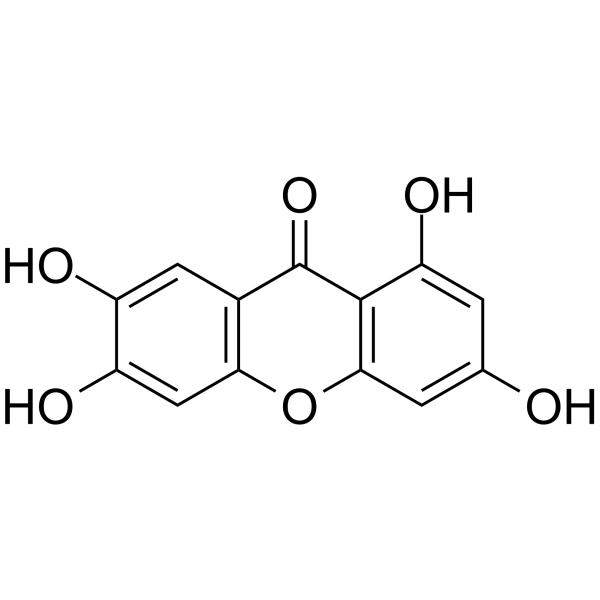
-
GP22010
NPL Human
N-acetylneuraminate Pyruvate Lyase Human Recombinant

-
GP22011
NQO1 Human
NAD(P)H Dehydrogenase Quinone 1 Human Recombinant

-
GP26169
NQO1 Human, Active
NQO1 Human Recombinant produced in E

-
GP22012
NQO2 Human
NAD(P)H Dehydrogenase Quinone 2 Human Recombinant

-
GC91667
NSC 44625
Bendroflumethiazide Impurity A,2,4-Disulfamyl-5-trifluoromethylaniline
NSC 44625 is an inhibitor of carbonic anhydrase II (CAII; Ki = 63 nM for the human enzyme).
-
GC65542
NSC-87877 disodium
8-羟基-7-[(6-磺基-2-萘基)偶氮基]-5-喹啉磺酸二钠盐
A potent inhibitor of SHP-1 and SHP- 2 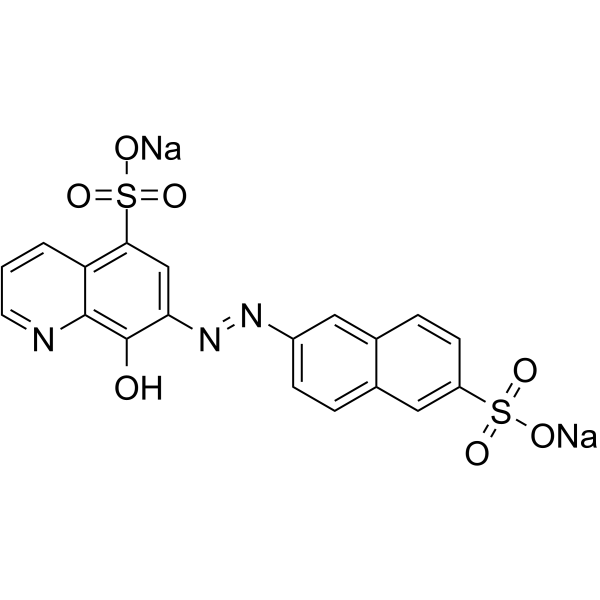
-
GP22013
NT5C2 Human
5'-Nucleotidase Cytosolic II Human Recombinant

-
GP22014
NT5C3B Human
5'-Nucleotidase, Cytosolic IIIB Human Recombinant

-
GP22015
NT5M Human
5',3'-Nucleotidase, Mitochondrial Human Recombinant

-
GP22017
NTH E.Coli
Endonuclease-III E.Coli Recombinant

-
GP22018
NTHL1 Human
Nth Endonuclease III-Like 1 Human Recombinant

-
GP22016
NTMT1 Human
N-Terminal Xaa-Pro-Lys N-Methyltransferase 1 Human Recombinant

-
GP26199
NTRK1 Rat
NTRK1 Rat Recombinant produced in HEK is a single, non-glycosylated polypeptide chain containing 623 amino acids (35-418 a

-
GP22019
NUDT1 Human
Nudix Type Motif 1 Human Recombinant

-
GP22021
NUDT10 Human
Nudix Type Motif 10 Human Recombinant

-
GP22022
NUDT14 Human
Nudix Type Motif 14 Human Recombinant

-
GP22023
NUDT16 Human
Nudix Type Motif 16 Human Recombinant

-
GP22024
NUDT16L1 Human
Nudix Type Motif 16 Like-1 Human Recombinant

-
GP22025
NUDT2 Human
Nudix Type Motif 2 Human Recombinant

-
GP22026
NUDT21 Human
Nudix Type Motif 21 Human Recombinant

-
GP22027
NUDT3 Human
Nudix Type Motif 3 Human Recombinant

-
GP22020
NUDT4 Human
Nudix Type Motif 4 Human Recombinant

-
GP22028
NUDT5 Human
Nudix 型基序 5 人类重组

-
GP22029
NUDT9 Human
Nudix Type Motif 9 Human Recombinant

-
GC49211
O-desmethyl Brinzolamide (hydrochloride)
An active metabolite of brinzolamide

-
GP22030
OAS1 Human
2’-5’ Oligoadenylate Synthetase 1 Human Recombinant

-
GP22031
ODC1 Human
Ornithine Decarboxylase 1 Human Recombinant

-
GP22032
OGG1 Human
8-Oxoguanine DNA Glycosylase Human Recombinant

-
GP22033
OGG1 Mouse
8-Oxoguanine DNA Glycosylase Mouse Recombinant

-
GP22035
OLA1 Human
Obg-Like ATPase 1 Human Recombinant

-
GC73677
Olgotrelvir sodium
STI-1558 sodium
Olgotrelvir sodium是一种口服活性的冠状病毒主要蛋白酶(Mpro)和人细胞组织蛋白酶(cathepsin L)的双重抑制剂。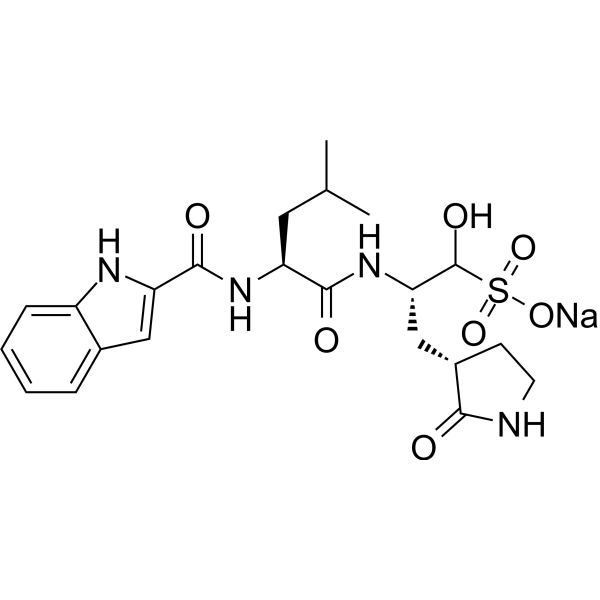
-
GC73707
ON 108600
ON 108600是CK2(酪蛋白激酶2)/TNIK/DYRK1的抑制剂,DYRK1A/DYRKB、DYRK2、CK2α1/CK2α2和TNIK的IC50分别为0.016μm/0.007μm、0.028μm、0.05μm/0.005μm和0.005μm。
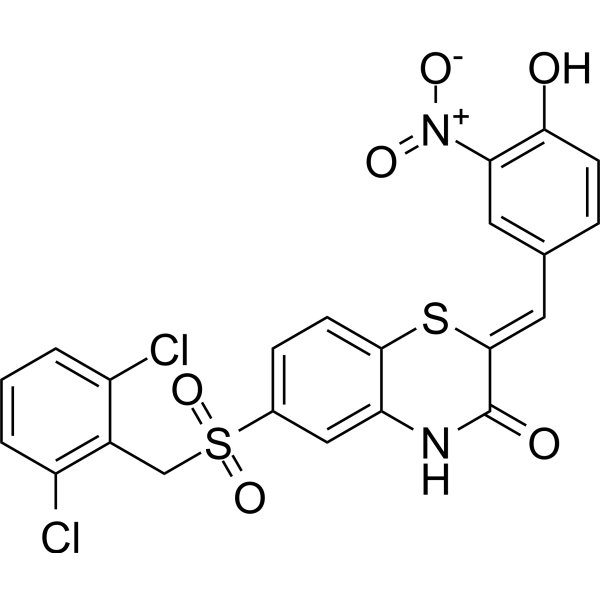
-
GC61158
ONO-5334
ONO-5334是一种强效、选择性和口服活性的组织蛋白酶K(cathepsinK)抑制剂,对人、兔和大鼠组织蛋白酶K的作用值分别为0.10nM、0.049nM和0.85nM。ONO-5334是一种有效的抗SAR-COV-2病毒活性的抗病毒化合物,其EC50值为500nM。ONO-5334有潜力用于骨质疏松症以及COVID-19的相关研究。
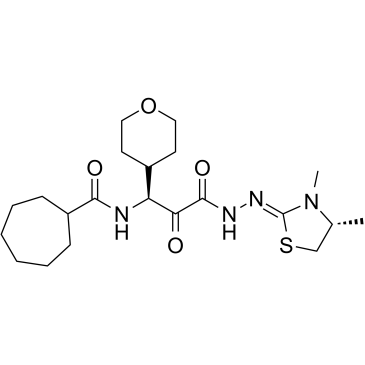
-
GC62210
ONX-0914 TFA
PR-957 TFA
A selective inhibitor of the β5i (LMP7) subunit of the immunoproteasome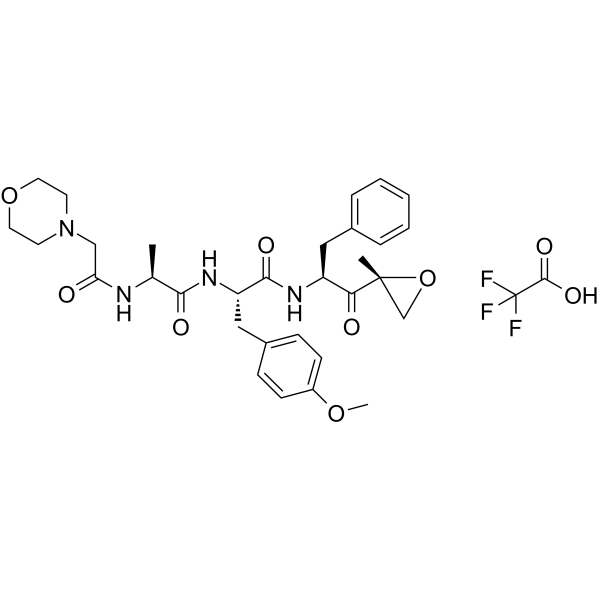
-
GP22036
Ornithine Aminotransferase Human
Ornithine Aminotransferase Human Recombinant





